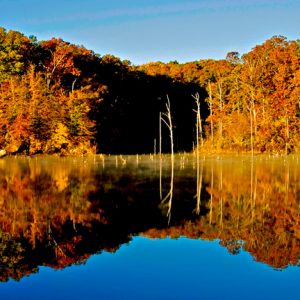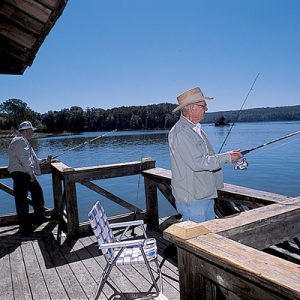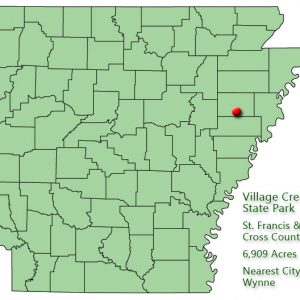calsfoundation@cals.org
Village Creek State Park
| Location: | Cross and St. Francis counties |
| Size: | 6,909 acres |
Village Creek State Park in northeast Arkansas, located six miles south of Wynne (Cross County), encompasses almost 7,000 acres along Crowley’s Ridge, preserving the ridge’s unique natural features. Park facilities occupy only a fraction of the total acreage, while the rest of the land remains in its natural state.
While Village Creek Park, named for a stream that flows through the area, is classified as a “natural” state park, it also preserves part of the rich history of the region. Early settlers named the area Old Cherokee Village, though there is little evidence of Cherokee occupation outside scattered camp remnants. A section of the 1820s Military Road that once linked Memphis, Tennessee, to Little Rock (Pulaski County) is still visible in the park. Once called the Memphis to Little Rock Road, it became a major route of Indian Removal for Muscogee (Creek), Chickasaw, and 600 Cherokee between 1832 and 1839. In addition, part of William Strong’s “delta empire” is preserved at Village Creek. The park contains part of Strong’s purchased Spanish land grants. He built his twenty-room mansion within view of Crowley’s Ridge, near the Military Road on land just east of the park boundary. Strong became one of the largest landowners and leading politicians in the region between 1820 and 1840. He became the first postmaster along the Military Road and served as county sheriff. He was a delegate to the Arkansas Constitutional Convention in 1836, the year of the state’s admission into the Union, and a delegate to the Arkansas General Assembly in 1840. Strong was instrumental in bringing the Military Road to the area, thus ensuring that its population would grow.
In 1967, the Arkansas legislature authorized a study to determine the need for a major park in the eastern part of the state. Thomas Seay of Forrest City (St. Francis County) was instrumental in getting the park established and in providing support and advice on the historic, natural, and cultural value of the land. As a result, land acquisition for Village Creek State Park started in 1972 and continued until 1978. The area satisfied the need for a recreational facility in eastern Arkansas. Much of the land was still in a natural state, and it was located between two large towns, though many of the landowners did not want to sell, having been in possession of the properties for many years or even generations.
The dedication of the park on June 27, 1976, was one of the largest celebrations of the American bicentennial in Arkansas, and it attracted many important state, national, and international guests, including Governor David Pryor. Country music star Charlie Rich, a native of the area, performed for an estimated crowed of 20,000.
Initial development at the park included a visitor center, limited camping, and a flag plaza featuring flags from all the governments that, through history, have laid claim to the land that is now Arkansas—France, Spain, the Confederate States of America, and the United States. Within a few years, the park added two beautiful lakes. The first, Lake Dunn, was named after Poindexter Dunn, who organized the first company from St. Francis County in the Civil War; he later represented the district in the U.S. Congress for five consecutive terms. The second, Lake Austell, was named after Samuel Austell, a senator and the first county judge of Cross County. Also added were picnic areas, campgrounds, hiking trails, a golf driving range, tennis and basketball courts, playgrounds, an amphitheater, and interpretive programs for visitors. Within the last twenty years, the park has constructed ten rental cabins, a 100-seat conference/special events room, a gift shop, and a museum that illustrates the uniqueness of Crowley’s Ridge’s natural division, early inhabitants, and natural communities. The park also added a horse camp with stables and a twenty-seven-hole golf course.
Village Creek State Park hosts several events throughout the year, including an annual triathlon and other athletic competitions, musicals, nature weekends, stargazing parties, presentations of historical cooking methods, day camps, and wildflower events.
For additional information:
Arkansas State Parks–Village Creek State Park. http://www.arkansasstateparks.com/villagecreek/ (accessed November 21, 2022).
Chowning, Robert W. History of St. Francis County, Arkansas. Forrest City, AR: Times-Herald Publishing Company, 1954.
Hartness, Richard L. Wittsburg, Arkansas: Crowley’s Ridge Steamboat River Port, 1848–1890. Little Rock, AR: Rose Publishing Company, 1979.
Staff of the Arkansas Department of Parks, Heritage and Tourism
 Lake Dunn
Lake Dunn  Village Creek State Park
Village Creek State Park  Village Creek State Park: Park Location
Village Creek State Park: Park Location 



In 1831-1833 members of the Choctaw tribe also traveled the Trail of Tears in what became Village Creek State Park.